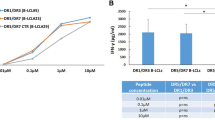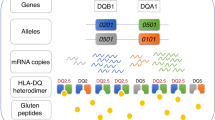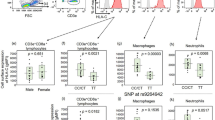Abstract
Celiac disease (CD) is a T-cell-mediated chronic inflammatory disease characterized by autoimmune, immunological and environmental components, where genetic factors in addition to the main known risk factors (gliadin and human leukocyte antigen (HLA)-DQ haplotypes) are supposed to be involved. CD14 is a multifunctional receptor involved in the bacterial lipopolysaccharides-dependent signal transduction. The CD14 gene maps on the long arm of chromosome 5 (5q22-q32), a ‘hotbed’ region for CD; promoter polymorphisms are known to influence its expression. In this study we analyzed three CD14 promoter polymorphisms (c.-1359G>T, c.-1145A>G and c.-159C>T, ) in 938 CD Italian patients and 533 healthy controls, with known HLA-DQ haplotypes, with the aim of evaluating their possible association with the disease. The c.-1145A>G G and c.-159C>T T alleles (as well as the combination of the two alleles in the GT haplotype), were identified as susceptibility factors for CD development, being significantly more frequent in CD patients than in healthy controls. This association was also confirmed when the analysis was restricted to only those subjects characterized by HLA-DQ risk haplotypes. Our results indicate the involvement of CD14 gene polymorphisms in the susceptibility to CD.
This is a preview of subscription content, access via your institution
Access options
Subscribe to this journal
Receive 6 digital issues and online access to articles
$119.00 per year
only $19.83 per issue
Buy this article
- Purchase on Springer Link
- Instant access to full article PDF
Prices may be subject to local taxes which are calculated during checkout
Similar content being viewed by others
References
Sollid LM . Celiac disease: dissecting a complex inflammatory disorder. Nat Rev Immunol 2002; 2: 647–655.
Alaedini A, Green PH . Narrative review: celiac disease: understanding a complex autoimmune disorder. Ann Intern Med 2005; 142: 289–298.
Ciclitira PJ, Johnson MW, Dewar DH, Ellis HJ . The pathogenesis of celiac disease. Mol Aspects Med 2005; 26: 421–458.
Robins G, Howdle PD . Advances in celiac disease. Curr Opin Gastroenterol 2005; 21: 152–161.
Qiao SW, Sollid LM, Blumberg RS . Antigen presentation in celiac disease. Curr Opin in Immunol 2009; 21: 111–117.
Vader W, Stepniak D, Kooy Y, Mearin L, Thompson A, van Rood JJ et al. The HLA-DQ2 gene dose effect in celiac disease is directly related to the magnitude and breadth of gluten-specific T cell responses. PNAS 2003; 100: 12390–12395.
Shan L, Molberg Ø, Parrot I, Hausch F, Filiz F, Gray GM et al. Structural basis for gluten intolerance in celiac sprue. Science 2002; 297: 2275–2279.
Reif S, Lerner A . Tissue transglutaminase the key player in celiac disease: a review. Autoimmun Rev 2004; 3: 40–45.
van Hell DA, Hunt K, Greco L, Wijmenga C . Genetics in celiac disease. Best Pract Res Clin Gastroenterol 2005; 19: 323–339.
Louka AS, Sollid LM . HLA in celiac disease: unravelling the complex genetics of a complex disorder. Tissue Antigens 2003; 61: 105–117.
Brandao LC, Vatta S, Guimaraes R, Segat L, Araujo J, De Lima Filho JL et al. Rapid genetic screening for major human leukocyte antigen risk haplotypes in patients with type 1 diabetes from Northeastern Brazil. Hum Immunol 2010; 71: 277–280.
Munthe-Kaas MC, Torjussen TM, Gervin K, Lødrup Carlsen KC, Carlsen KH, Granum B et al. CD14 polymorphisms and serum CD14 levels through childhood: a role for gene methylation? J Allergy Clin Immunol 2010; 125: 1361–1368.
Medzhitov R . Toll-like receptors and innate immunity. Nat Rev Immunol 2001; 1: 135–145.
Medzhitov R, Janeway C . Innate immunity. N Engl J Med 2000; 343: 338–344.
Vercelli D, Baldini M, Martinez F . The monocyte/IgE connection: may polymorphisms in the CD14 gene teach us about IgE regulation? Int Arch Allergy Immunol 2001; 124: 20–24.
Boniotto M, Braida L, Ventura A, Percopo S, Amoroso A, Crovella S . Promoter polymerphisms of the CD14 gene in Italian patients with celiac disease. J Med Genet 2003; 40: e108.
Holla LI, Buckova D, Fassmann A, Halabala T, Vasku A, Vacha J . Promoter polymorphisms in the CD14 receptor gene and their potential association with the severity of chronic periodontitis. J Med Genet 2002; 39: 844–848.
Gu W., Dong H, Jiang D, Zhou J, Du DY, Gao JM et al. Fuctional significance of CD14 promoter polymorphisms and their clinical relevance in a Chinese Han population. Crit Care Med 2008; 36 (8): 2274–2280.
Litonjua AA, Belanger K, Celedón JC, Milton DK, Bracken MB, Kraft P et al. Polymorphisms in the 5’ region of the CD14 gene are associated with eczema in young children. J Allergy Clin Immunol 2005; 115: 1056–1062.
Karell K, Louka AS, Moodie SJ, Ascher H, Clot F, Greco L et al. European Genetics Cluster on Celiac Disease. HLA types in celiac disease patients not carrying the DQA1*05-DQB1*02 (DQ2) heterodimer: results from the European Genetics Cluster on Celiac Disease. Hum Immunol 2003; 64: 469–477.
Excoffier L, Laval G, Schneider S . Arlequin ver 3.0: an integrate software package for population genetics data analysis. Evol Bioinform Online 2005; 1: 47–50.
Latiano A, Mora B, Bonamico M, Megiorni F, Mazzilli MC, Cucchiara S et al. Analysis of candidate genes on chromosome 5q and 19p in celiac disease. J Pediatr Gastroenterol Nutr 2007; 45: 180–186.
Greco L, Corazza G, Babron MC, Clot F, Fulchignoni-Lataud MC, Percopo S et al. Genome search in celiac disease. Am J Hum Genet 1998; 62: 669–675.
Naluai AT, Nilsson S, Gudjónsdóttir AH, Louka AS, Ascher H, Ek J et al. Genome-wide linkage analysis of Scandinavian affected sib-pairs supports presence of susceptibility loci for celiac disease on chromosome 5 and 11. Eur J Hum Genet 2001; 9: 938–944.
Liu J, Juo SH, Holopainen P, Terwilliger J, Tong X, Grunn A et al. Genomewide linkage analysis of celiac disease in Finnish families. Am J Hum Genet 2002; 70: 51–59.
Koskinen LL, Einarsdottir E, Korponay-Szabo IR, Kurppa K, Kaukinen K, Sistonen P et al. Fine mapping of the CELIAC2 locus on chromosome 5q31-q33 in the Finnish and Hungarian populations. Tissue Antigens 2009; 74: 408–416.
Adamovic S, Amundsen SS, Lie BA, Hellqvist A, Gudjònsdòttir AH, Ek J et al. Fine mapping study in Scandinavian families suggests association between coeliac disease and haplotypes in chromosome region 5q32. Tissue Antigens 2008; 71: 27–34.
Zhong F, McCombs CC, Olson JM, Elston RC, Stevens FM, McCarthy CF et al. An autosomal screen for genes that predispose to celiac disease in the Western counties of Ireland. Nat Genet 1996; 14: 329–333.
Babron MC, Nilsson S, Adamovic S, Naluai AT, Wahlström J, Ascher H et al. Meta and pooled analysis of European coeliac disease data. Eur J Hum Genet 2003; 11: 828–834.
Lander E, Kruglyak L . Genetic dissection of complex traits: guidelines for interpreting and reporting linkage results. Nat Genet 1995; 11: 241–247.
Amundsen SS, Adamovic S, Hellqvist A, Nilsson S, Gudjònsdòttir AH, Ascher H et al. A comprehensive screen for SNP associations on chromosome region 5q31-33 in Swedish/Norwegian celiac disease families. Eur J Hum Genet 2007; 15: 9809–9807.
Inohara N, Ogura Y, Nunez G . Nods: a family of cytosolic proteins that regulate the host response to pathogens. Curr Opin Microbiol 2002; 5: 76–80.
Takeda K, Kaisho T, Akira S . Toll-like receptors. Annu Rev Immunol 2003; 21: 335–376.
Baldini M, Lohman IC, Halonen M, Erickson RP, Holt PG, Martinez FD . A polymorphism in the 5' flanking region of the CD14 gene is associated with circulating soluble CD14 levels and with total serum Immunoglobulin E. Am J Respir Cell Mol Biol 1999; 20: 976–983.
Hubacek JA, Rothe G, Pit'ha J, Skodová Z, Staněk V, Poledne R et al. C-260T polymorphism in the promoter of the CD14 monocyte receptor gene as a risk factor for myocardial infarction. Circulation 1999; 99: 3218–3220.
LeVan TD, Bloom JW, Bailey TJ, Karp CL, Halonen M, Martinez FD et al. A common single nucleotide polymorphism in the CD14 promoter decreased the affinity of Sp protein binding and enhances transcriptional activity. J Immunol 2001; 167: 5838–5844.
Mertens J, Bregadze R, Mansur A, Askar E, Bickeböller H, Ramadori G et al. Functional impact of endotoxin receptor CD14 polymorphisms on transcriptional activity. J Mol Med 2009; 87: 815–824.
Dezsofi A, Szebeni B, Hermann CS, Kapitány A, Veres G, Sipka S et al. Frequencies of genetics polymorphisms of TLR4 and CD14 and HLA-DQ genotypes in children with celiac disease, type 1 diabetes mellitus, or both. J Pediatr Gastroenterol Nutr 2008; 47: 283–287.
Fernandes AP, Foss MC, Donadi EA . HLA-DQB1 alleles may influence the surface expression of DQ molecules in lymphomononuclear cells of type 1 diabetes mellitus patients. Scand J Immunol 2004; 59: 305–309.
Walker-Smith JA, Guandalini S, Schmitz J, Shmerling DH, Visakorpi JK . Revised criteria for diagnosis of celiac disease. Report of Working Group of European Society of Paediatric Gastroenterology and Nutrition. Arch Dis Child 1990; 65: 909–911.
Kaukinen K, Mäki M, Partanen J, Sievänen H, Collin P . Celiac disease without villous atrophy: revision of criteria called for. Dig Dis Sci 2001; 46: 879–888.
Järvinen TT, Collin P, Rasmussen M, Kyrönpalo S, Mäki M, Partanen J et al. Villous tip intraepithelial lymphocytes as markers of early-stage celiac disease. Scand J Gastroenterol 2004; 39: 428–433.
Monsuur AJ, de Bakker PI, Zhernakova A, Pinto D, Verduijn W, Romanos J et al. Effective detection of human leukocyte antigen risk alleles in celiac disease using tag single nucleotide polymorphisms. PLoS ONE 2008; 3: e2270.
Koskinen L, Romanos J, Kaukinen K, Mustalahti K, Korponay-Szabo I, Barisani D et al. Cost-effective HLA typing with tagging SNPs predicts celiac disease risk haplotypes in the Finnish, Hungarian, and Italian populations. Immunogenetics 2009; 61: 247–256.
Vatta S, Fabris A, Segat L, Not T, Crovella S . Tag-single nucleotide polymorphism-based human leukocyte antigen genotyping in celiac disease patients from northeastern Italy. Hum Immunol 2011; 72: 499–502.
Acknowledgements
This study has been supported by a grant (RC03/04) from the IRCCS Burlo Garofolo, Trieste (Italy). SC is recipient of a fellowship grant from European Project “Talents for an International House” within the framework of the 7th Research and Development Framework Program PEOPLE – Marie Curie Actions – COFUND (Co-Funding of Regional, National and International Programmes).
Author information
Authors and Affiliations
Corresponding author
Ethics declarations
Competing interests
The authors declare no conflict of interest.
Additional information
Supplementary Information accompanies the paper on Genes and Immunity website
Supplementary information
Rights and permissions
About this article
Cite this article
Catamo, E., Segat, L., Lenarduzzi, S. et al. CD14 polymorphisms correlate with an augmented risk for celiac disease in Italian patients. Genes Immun 13, 489–495 (2012). https://doi.org/10.1038/gene.2012.23
Received:
Revised:
Accepted:
Published:
Issue Date:
DOI: https://doi.org/10.1038/gene.2012.23



